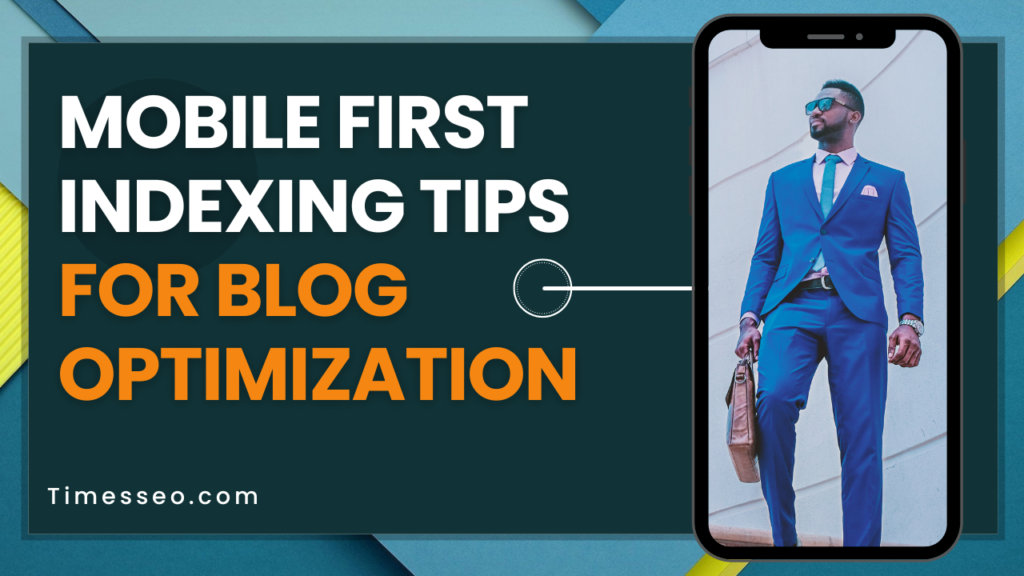
Mobile First Indexing Tips for Blog Optimization
This blog post shares essential mobile first indexing tips to help bloggers optimize their sites for better rankings and user experience. It covers strategies like responsive design, faster loading speeds, mobile-friendly navigation, and content formatting, ensuring your blog performs well in Google’s mobile-first world.
Table of Contents
Introduction
Mobile-first indexing is Google’s way of saying, “We care about your mobile visitors more than ever.” In simple terms, Google now primarily uses the mobile version of your site to determine rankings. You’re essentially instructing Google to rank you lower on the list if your blog isn’t responsive.
What is Mobile-First Indexing?
It’s when Google uses your mobile site as the main version for crawling and indexing. Think of it as Google wearing mobile glasses—it sees your site as your visitors do on their phones.
Why Google Prioritizes Mobile Content
More than 60% of all website visits come from mobile devices. That’s a huge reason Google gives mobile-first indexing so much importance.
The Impact on SEO
If your mobile site is slow, hard to read, or missing content, your rankings will drop—regardless of how beautiful your desktop version is.
Understanding Mobile User Behavior
Rise of Mobile Traffic
The smartphone has become the “go-to” device for reading blogs, checking news, and shopping. You can’t afford to ignore this audience.
How Mobile Users Interact Differently with Blogs
Mobile users skim content, prefer short sentences, and appreciate visuals that load quickly. They don’t like pinching and zooming to read text.
Mobile First Indexing Tips for Blogs
Use a Mobile-Responsive Theme
Choose a theme that adapts to different screen sizes without breaking the layout.
Optimize Images for Faster Loading
Images should be resized and compressed before being posted to your blog.
Ensure Readable Font Sizes
No one wants to squint. Aim for at least 16px body text.
Avoid Intrusive Pop-Ups
Google penalizes sites that use full-screen pop-ups that block content.
Use Proper Heading Hierarchy
Keep headings logical (H1 → H2 → H3) for SEO and readability.
Test with Google’s Mobile-Friendly Tool
Get instant feedback on how your site performs on mobile.
Core Principles for Mobile Optimization
Responsive Web Design
Your blog should automatically adjust to any screen size—whether it’s an iPhone, Android, or tablet.
Page Speed Optimization
Compress images, use a caching plugin, and consider a content delivery network (CDN) to boost speed.
Mobile-Friendly Navigation
Menus should be simple, thumb-friendly, and easy to tap without zooming.
SEO Content Strategy for Mobile
Write Shorter Paragraphs
Keep it scannable—3-4 sentences max.
Use Bullet Points for Readability
Perfect for lists, tips, and quick takeaways.
Include Mobile-Friendly Visuals
Use compressed images, SVG icons, and videos that resize automatically.
Optimize Meta Titles and Descriptions for Small Screens
Keep them concise so they don’t get cut off in mobile search results.
Technical Optimization for Mobile First Indexing
Structured Data for Mobile
Make sure your schema markup is mobile-friendly for rich snippets.
Mobile Sitemap Optimization
Ensure all mobile pages are in your sitemap.
Ensure Same Content on Mobile and Desktop
Don’t hide valuable content just for mobile—it could hurt rankings.
Optimize Internal Linking for Mobile
Links should be easy to tap, and related content should be accessible.
Tracking Mobile SEO Performance
Using Google Search Console for Mobile Reports
Check mobile usability reports to fix errors quickly.
Monitoring Mobile Page Speed with PageSpeed Insights
Get actionable tips to improve speed.
Tracking User Engagement Metrics
Look at bounce rates, session duration, and clicks to see how mobile visitors engage.
Common Mobile SEO Mistakes to Avoid
Hiding Content on Mobile
Google expects the same valuable content across all devices.
Slow Mobile Loading Speeds
You risk losing visitors with every extra second of loading time.
Overusing Heavy Scripts
Too many scripts slow your mobile site dramatically.
Future of Mobile-First Indexing
Voice Search Integration
More mobile searches are voice-based—optimize for conversational keywords.
AI-Powered Mobile SEO Tools
Anticipate more intelligent solutions that will automatically identify and address mobile SEO problems.
Conclusion
Mobile-first indexing is the way of the future, not just a fad. If you want your blog to rank, you must prioritize mobile optimization. A responsive design, faster loading times, and mobile-friendly content will keep both Google and your visitors happy.
Frequently Asked Questions
At least every 3 months, or after major design changes.
Not if your mobile and desktop versions are consistent.
It’s possible but very unlikely in competitive niches.
Switch to a responsive theme and compress images.
They prefer concise, scannable posts—but depth still matters.
Table of Contents
Popular Posts
-
 Affordable Technical SEO Audit for Small Business: A Complete Guide26 Jun 2025 Blog
Affordable Technical SEO Audit for Small Business: A Complete Guide26 Jun 2025 Blog -
 How to Get an Affordable Technical SEO Audit for Small Business27 Jun 2025 Blog
How to Get an Affordable Technical SEO Audit for Small Business27 Jun 2025 Blog -
 The Ultimate Local SEO Audit Checklist for Startups28 Jun 2025 Blog
The Ultimate Local SEO Audit Checklist for Startups28 Jun 2025 Blog -
 Local SEO Audit Checklist for Startups: A Beginner’s Guide28 Jun 2025 Blog
Local SEO Audit Checklist for Startups: A Beginner’s Guide28 Jun 2025 Blog -
 Top On-Page SEO Audit Steps for Service Websites Every Business Should Know29 Jun 2025 Blog
Top On-Page SEO Audit Steps for Service Websites Every Business Should Know29 Jun 2025 Blog -
 Technical SEO for WordPress: The Ultimate Beginner’s Guide01 Jul 2025 Blog
Technical SEO for WordPress: The Ultimate Beginner’s Guide01 Jul 2025 Blog -
 The Impact of On-Page SEO Audit Steps for Service Websites on UX01 Jul 2025 Blog
The Impact of On-Page SEO Audit Steps for Service Websites on UX01 Jul 2025 Blog -
 Technical Mobile SEO Audit Tips for Developers02 Jul 2025 Blog
Technical Mobile SEO Audit Tips for Developers02 Jul 2025 Blog -
 Complete SEO Backlink Audit Guide for Better Google Rankings03 Jul 2025 Blog
Complete SEO Backlink Audit Guide for Better Google Rankings03 Jul 2025 Blog -
 Boost Your Rankings with Technical SEO for WordPress01 Jul 2025 Blog
Boost Your Rankings with Technical SEO for WordPress01 Jul 2025 Blog






